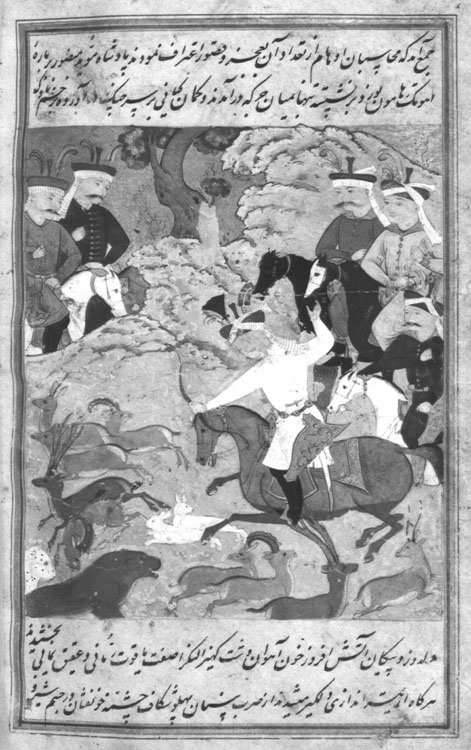Date of this event: 911/1505-6
After having his fill of looking at the spring flowers and the other festivities during the Nowruz celebration of 911/1505-6, Shāh Esmāʿil decided to go hunting. He gave the order to all rulers and nobles from Iraq and Fārs to Qom that they should join him on the mountain outside Isfahan, driving before them as they come all manner of animals suitable for hunting. A great number of dignitaries responded, arriving with cymbals clashing and horns blowing. The frightened animals of every species - deer, rabbits, lions, tigers, onagers, foxes, ibex, goats, moufflon - were herded before them to the predetermined spot to serve as sport for the king and his nobles. Altogether, the text claims, a total of 56,706 animals were killed and divided amongst them. And from their remains a minaret was built at the Soleiman gateway to Isfahan.
In thepainting, Esmāʿil is shown mounted in the right foreground, having just released an arrow. In front of the shah, a wild goat falls with two arrows embedded in its flesh. Other animals - ibex, a second goat, deer, and rabbits - scurry toward the left to escape Esmāʿil’s onslaught, while in the extreme foreground more animals - deer, ibex, a goat, lion, and a leopard - are fleeing in a file to the right, having turned after having presumably run into some obstruction beyond the left margin, such as other hunters or a net (cf. folio 205). Altogether thirteen animals are represented. Five observers, all mounted and wearing the Safavid tāj, accompany the shah but do not actively participate. Three are grouped on the right just behind the shah, while two others appear from behind the ridge. The scene takes place on a hillside not unlike the backdrop for the other paintings in this manuscript, but the hill crests with an unusually craggy ridge on which a single tree rises just to the left of the vertical center line.
Painting: 14.1 x 12.0 cm. Two lines of text above and below the painting. Frame encloses painting and text. The features of the shah’s face have been obliterated by abrasion, and there is a fine horizontal tear across the entire page about one-third of the way down from the top. Other minor abrasions but none seriously affecting the painting. No signs of retouching. Unsigned.
Painting references:
Unpublished.
Robert Eng
Last updated: November 22, 2010
